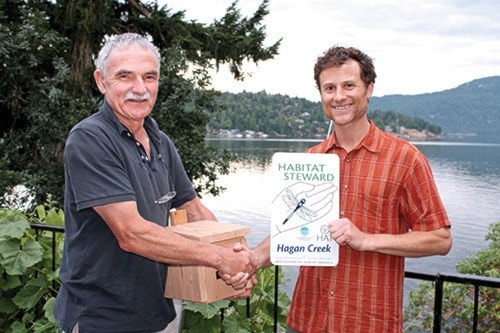This summer, Todd Carnahan of Habitat Acquisition Trust (HAT) will be busy meeting with residents around the Hagan and Tod watersheds to encourage them to become stewards of the land.
HAT is a regional land trust that was established in 1996 by the Victoria Natural History Society. The not-for-profit group has been working in the Capital Regional District and the southern Gulf Islands to preserve and improve natural areas with the help of volunteers and other groups like the Peninsula Streams Society.
“We have over 500 families who have become habitat stewards from Sooke to Galiano,” said Carnahan, adding he hopes to add more this summer from the Saanich Peninsula.
“Our aim is to give people the information they need to make educated decisions on how they care for their properties. It’s about getting people to think about being part of a solution instead of feeling like there’s nothing they can do.”
Carnahan and HAT have worked with one Brentwood Bay resident, Michael Simmons, for about eight years.
Simmons, who is also a member of other organizations like Peninsula Streams and the Saanich Inlet Protection Society, has used information from HAT to educate himself on invasive species removal, naturescaping and how to keep his waterfront property from eroding.
“We built a proper seawall to prevent erosion of our property and other properties around us. We planted natural gardens including an expanded wildflower garden, we removed invasive species from our property and replaced things like bamboo with plants native to the area,” said Simmons, a retired environmental consultant, who added his enthusiasm for land stewardship comes from living on the Saanich Peninsula.
“When you live somewhere like this, you can’t help but be aware and appreciative of your surroundings and willing to help preserve it,” he said.
Carnahan hopes to get other waterfront property owners as well as property owners from Tod Flats to Mount Newton involved in improving surrounding areas of Hagan Creek, which is one of the area’s only trout-bearing streams.
“The creek has a lot of natural value for that alone,” said Carnahan,
“What we hope to do is increase the creek’s health and the quality of the water in it. One thing about creeks like Hagan, which drain into a contained body of water like the Saanich Inlet, is that the water has to be clean.”
By increasing the health of the creek, Carnahan said HAT also hopes to bring back the health of the clam beds where the stream empties at KENNES Bight.
“Healthy trout streams and clam beds form a vision for the future in rural Central Saanich,” said Carnahan.
HAT cooperates with streamside landowners in order to reduce stream threats like stream bank erosion, contaminated road runoff, invasive weed species, and pests like deer and geese.
HAT will also help landowners pursue stream stewardship initiatives established by the Peninsula Streams Society as well as host restoration workshops for residents interested in stream-side tree planting activities.
“We come out and walk the property with the landowner and identify possible improvements or adjustments to their land. Then we tailor the recommendations to the ability and interests of the owners. It’s all voluntary activities,” said Carnahan.
Residents can request a free information package with practical ideas on landscaping, water efficiency and attracting songbirds and biologists from HAT can meet with residents to look at the unique challenges and opportunities for every property and follow up with science-based recommendations. Visits and land care recommendations by HAT are free of charge and confidential.
For more information on HAT and the Good Neighbors Project, contact Todd Carnahan at 250-995-2428 or email todd@hat.bc.ca.
Do you have what it takes to become a HAT Good Neighbour?
The HAT Good Neighbours Land Care Agreement is a signed agreement between HAT and a landowner (not legally binding and called a ‘handshake agreement’ by HAT) asks that families apply as many of these care practices to their land as they choose:
• install efficient irrigation and naturescaping
• avoid pesticides and synthetic fertilizers
• remove invasive weeds like broom and daphne
• spread the word about protecting species at risk
• keep oil and other toxics out of rain drains
• maintain and protect soil with leaf mulch
• plant and protect stream buffers for fish and clams
